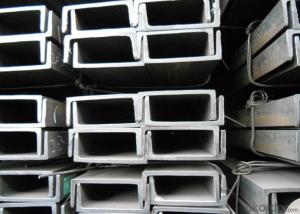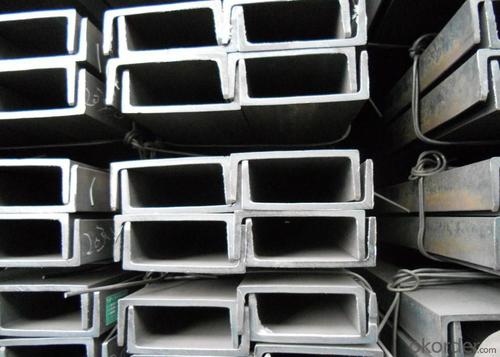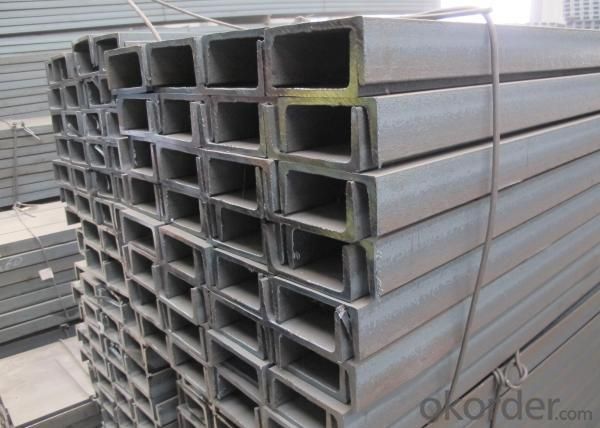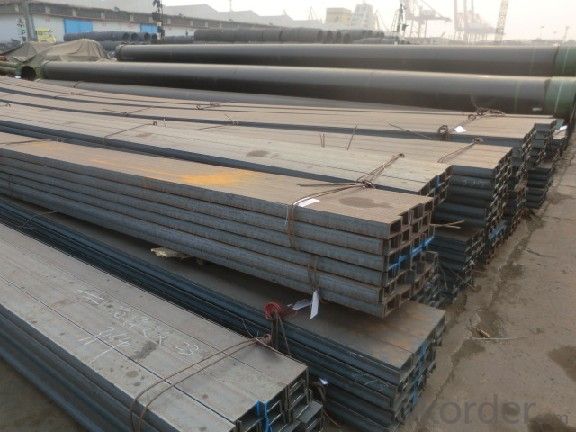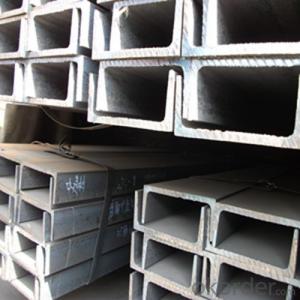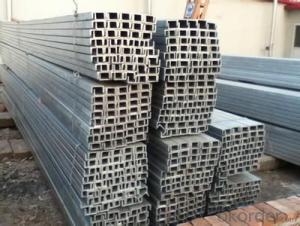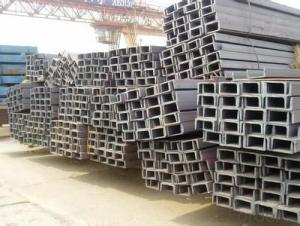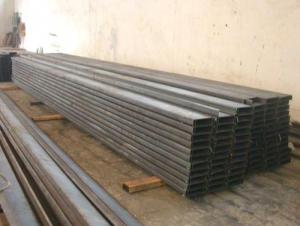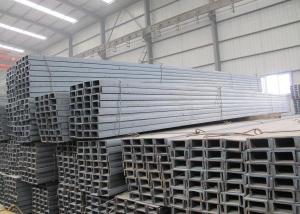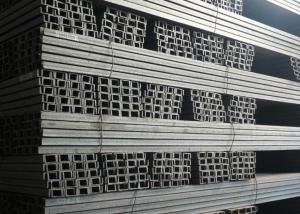U Channel Steel/Steel Channel /Galvanized Steel Channel
- Loading Port:
- Tianjin
- Payment Terms:
- TT OR LC
- Min Order Qty:
- 25 m.t
- Supply Capability:
- 20000 m.t/month
OKorder Service Pledge
OKorder Financial Service
You Might Also Like
Product Description:
OKorder is offering U Channel Steel/Steel Channel /Galvanized Steel Channelprices with worldwide shipping. Our supplier is a world-class manufacturer of steel, with our products utilized the world over. OKorder annually supplies products to European, North American and Asian markets. We provide quotations within 24 hours of receiving an inquiry and guarantee competitive prices.
Product Applications:
U Channel Steel/Steel Channel /Galvanized Steel Channel are ideal for structural applications and are widely used in the construction of buildings and bridges, and the manufacturing, petrochemical, and transportation industries.
Product Advantages:
OKorder's U Channel Steel/Steel Channel /Galvanized Steel Channel durable, strong, and resist corrosion.
Main Product Features:
· Premium quality
· Prompt delivery & seaworthy packing (30 days after receiving deposit)
· Corrosion resistance
· Can be recycled and reused
· Mill test certification
· Professional Service
· Competitive pricing
Product Specifications:
Specifications of Steel U Channel:
Standard Applied: GB Standard, EN Standard(UPN), JIS Standard
Sizes: 50mm to 300mm
Material Grade: Q235B, Q345B, S235JR, SS400, ASTM A36
As shown in the figure:
JIS U CHANNEL | Standard h | Sectional b | Dimension s | t | Mass: Kg/m |
(mm) | (mm) | (mm) | (mm) | ||
50x25 | 50 | 25 | 3.0 | 6.00 | 2.37 |
75X40 | 75 | 40 | 3.8 | 7.00 | 5.30 |
75X40 | 75 | 40 | 4.0 | 7.00 | 5.60 |
75X40 | 75 | 40 | 4.5 | 7.00 | 5.85 |
75X40 | 75 | 40 | 5.0 | 7.00 | 6.92 |
100X50 | 100 | 50 | 3.8 | 6.00 | 7.30 |
100X50 | 100 | 50 | 4.2 | 6.00 | 8.03 |
100X50 | 100 | 50 | 4.5 | 7.50 | 8.97 |
100X50 | 100 | 50 | 5.0 | 7.50 | 9.36 |
125X65 | 125 | 65 | 5.2 | 6.80 | 11.66 |
125X65 | 125 | 65 | 5.3 | 6.80 | 12.17 |
125X65 | 125 | 65 | 5.5 | 8.00 | 12.91 |
125X65 | 125 | 65 | 6.0 | 8.00 | 13.40 |
150x75 | 150 | 75 | 5.5 | 7.30 | 14.66 |
150x75 | 150 | 75 | 5.7 | 10.00 | 16.71 |
150x75 | 150 | 75 | 6.0 | 10.00 | 17.90 |
150x75 | 150 | 75 | 6.5 | 10.00 | 18.60 |
Note: We are able to supply other dimensions and sizes, which depends on the customer's requirements for the quantity.
Chemical Composition of Q235B Steel U Channel:
Alloy No | Grade | Element(%) | ||||
C | Mn | S | P | Si | ||
Q235 | B | 0.12-0.20 | 0.3-0.7 | ≦0.045 | ≦0.045 | ≦0.3 |
Package & Delivery of JIS U Channel Steel:
1.The JIS u channel steel will be packed in bundle with steel wire at each end of every bundle and color marking in order to help the customer to recognize his goods more easily at sight.
2. And the channel steel could be loaded into 20ft or 40ft container, or by bulk cargo.If the weight of each bundle reaches more than 3.5 mt, the loading by break bulk cargo should be choosed.When the weight of each bundle reaches less than 3mt, the loading by container should be choosed.
3.As for the transportaion from mill to loading port, the truck will be usually used. And the maximum quantity for each truck is 40mt.
4.All in all, we could do in accordance with customer's request.
FAQ:
Q1: Why buy Materials & Equipment from OKorder.com?
A1: All products offered byOKorder.com are carefully selected from China's most reliable manufacturing enterprises. Through its ISO certifications, OKorder.com adheres to the highest standards and a commitment to supply chain safety and customer satisfaction.
Q2: What makes stainless steel stainless?
A2: Stainless steel must contain at least 10.5 % chromium. It is this element that reacts with the oxygen in the air to form a complex chrome-oxide surface layer that is invisible but strong enough to prevent further oxygen from "staining" (rusting) the surface. Higher levels of chromium and the addition of other alloying elements such as nickel and molybdenum enhance this surface layer and improve the corrosion resistance of the stainless material.
Q3: Can stainless steel rust?
A3: Stainless does not "rust" as you think of regular steel rusting with a red oxide on the surface that flakes off. If you see red rust it is probably due to some iron particles that have contaminated the surface of the stainless steel and it is these iron particles that are rusting. Look at the source of the rusting and see if you can remove it from the surface.
Images:
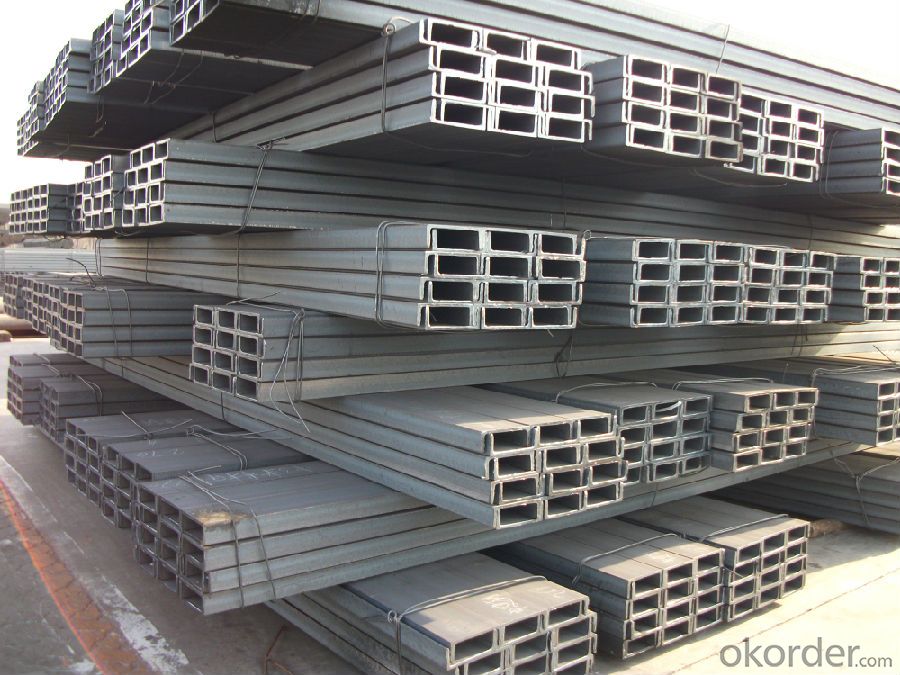
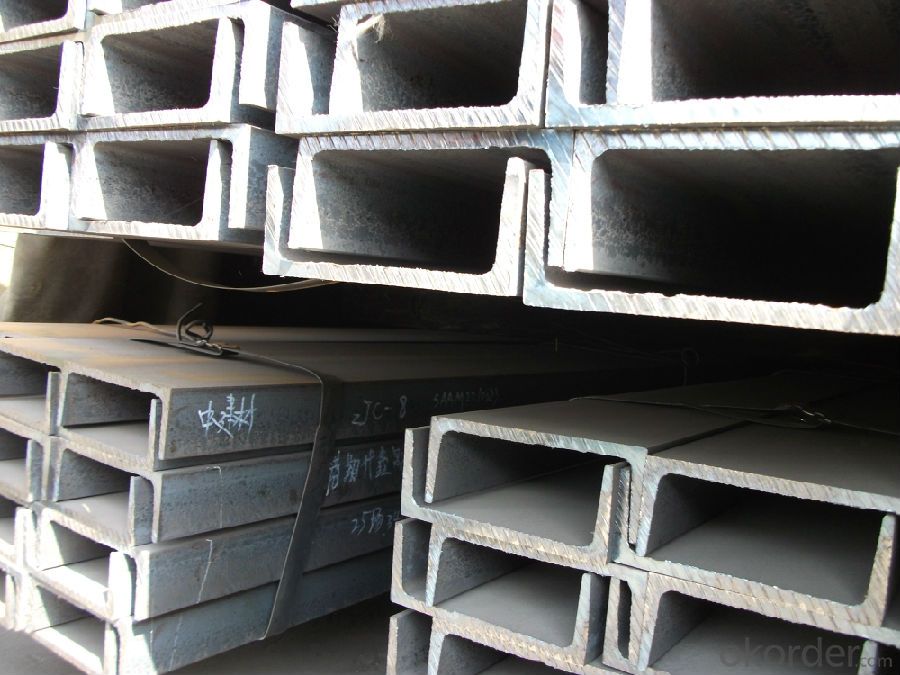
- Q: Can steel channels be used in industrial applications?
- Yes, steel channels can definitely be used in industrial applications. Steel channels are versatile structural components that are commonly used in various industries due to their strength, durability, and load-bearing capabilities. They are often used to support heavy loads, provide structural stability, and create frameworks for machinery, equipment, and infrastructure in industrial settings. Steel channels are also utilized in construction, manufacturing, engineering, and transportation industries for applications such as building frames, conveyor systems, shelving units, bridges, and support beams. Moreover, steel channels can be easily fabricated, welded, and customized to meet specific industrial requirements, making them a popular choice in a wide range of industrial applications.
- Q: How do steel channels contribute to the overall safety of a building?
- Steel channels are an integral component that contributes significantly to the overall safety of a building. These structural members play a crucial role in providing stability, strength, and support to the entire structure. Firstly, steel channels help to distribute the weight and loads of the building evenly throughout the structure. By acting as load-bearing members, they help to transfer the weight of the building to the foundation, ensuring that the structure remains stable and can withstand the forces it may encounter, such as wind, seismic activity, or heavy snow loads. Furthermore, steel channels are designed to resist bending or buckling, which enhances the structural integrity of the building. This resistance to deformation is particularly important in areas prone to earthquakes or high winds, as it helps to prevent the collapse of the structure during such events. Steel channels also contribute to fire safety in buildings. Unlike other construction materials, steel has excellent fire-resistant properties. It does not burn, melt, or release toxic gases when exposed to high temperatures. Therefore, steel channels provide added protection by preventing the spread of fire and maintaining the structural stability of the building, giving occupants more time to evacuate safely. Moreover, steel channels are highly durable and corrosion-resistant. This durability ensures that the building maintains its strength and stability over time, reducing the risk of structural failure due to material degradation. It also reduces the need for frequent maintenance and repairs, thus enhancing the long-term safety of the building. In summary, steel channels play a vital role in ensuring the overall safety of a building. They provide stability, strength, and support, distributing loads evenly, resisting bending and buckling, and contributing to fire safety. Their durability and corrosion resistance further enhance the long-term safety of the structure. Therefore, incorporating steel channels into the construction of a building is essential for creating a safe and secure environment for its occupants.
- Q: How do steel channels contribute to the overall sustainability of a building?
- Steel channels contribute to the overall sustainability of a building in several ways. Firstly, steel is a highly durable material that has a long lifespan, which means that steel channels used in construction can withstand the test of time. This durability reduces the need for frequent repairs or replacements, thus minimizing the consumption of resources and reducing waste. Furthermore, steel channels have a high strength-to-weight ratio, making them a lightweight yet sturdy option for structural components. This characteristic allows for more efficient construction practices, as less material is required to achieve the same strength and load-bearing capacity. Consequently, the use of steel channels can reduce the overall weight of the building, resulting in lower energy consumption during transportation and construction. Another aspect of steel channels that contributes to sustainability is their recyclability. Steel is one of the most recycled materials in the world, with a high recycling rate. At the end of a building's lifespan, steel channels can be easily dismantled and recycled, preventing them from ending up in landfills. This recycling process saves energy and natural resources that would be required to produce new steel, and it helps to reduce greenhouse gas emissions associated with the production of virgin steel. In addition, the use of steel channels in construction allows for flexibility in design and adaptability in the future. Steel structures can be easily modified or expanded, making them adaptable to changing needs without the need for significant demolition or reconstruction. This adaptability reduces the waste generated during renovations and minimizes the environmental impact of the building throughout its lifecycle. Lastly, steel channels offer excellent fire resistance properties, which enhances the safety and resilience of a building. Steel does not burn, melt, or contribute to the spread of flames, making it a suitable material for fire-resistant construction. By incorporating steel channels in the building's structure, the risk of fire-related damages is reduced, leading to increased safety and reduced environmental impact. In summary, steel channels contribute to the overall sustainability of a building by being durable, lightweight, recyclable, adaptable, and fire-resistant. These characteristics result in the efficient use of resources, lower energy consumption, reduced waste generation, and enhanced safety. Incorporating steel channels in construction not only ensures the longevity of the building but also helps to minimize its environmental footprint.
- Q: What are the deflection limits for steel channels?
- Various factors, including the type of steel, channel size and shape, and intended application, can cause the deflection limits for steel channels to vary. However, engineering standards and codes generally establish accepted deflection limits in the industry. Typically, the deflection limits for steel channels are determined based on the maximum allowable deflection to maintain structural integrity and functionality. This limit is usually expressed as a ratio of the channel's span length to its depth. For instance, the American Institute of Steel Construction (AISC) outlines deflection limit guidelines in their specification. According to AISC, for simply supported steel channels, the recommended deflection limit is L/300, with L representing the span length. This means that the deflection should not exceed one-thirtieth of the span length. It is important to note that different types of steel channels, such as those used in heavy-duty applications or subjected to dynamic loads, may have varying deflection limits. In such cases, stricter limits may be specified to ensure the channel can handle the intended loads without significant deformation. Additionally, deflection limits should be considered alongside other design factors like strength, stability, and serviceability requirements. The overall design of the steel channel should consider these factors to ensure a secure and dependable structure. To determine the specific deflection limits for a particular steel channel, it is advisable to consult relevant design codes and standards. Seeking the guidance of a professional structural engineer, who can provide accurate and specific advice based on project requirements, is also recommended.
- Q: Can steel channels be used in interior design applications?
- Yes, steel channels can be used in interior design applications. Steel channels are versatile and durable, making them suitable for a variety of design purposes. They can be used as structural elements, decorative accents, or even functional features in interior spaces. Steel channels can be creatively incorporated into architectural details such as room dividers, wall paneling, shelving units, and furniture pieces. Their sleek and modern appearance adds an industrial and contemporary touch to any interior design style. Additionally, steel channels can be customized in terms of size, finish, and shape to meet specific design requirements, making them a flexible choice for interior designers.
- Q: Can steel channels be used in stadium construction?
- Yes, steel channels can be used in stadium construction.
- Q: How do steel channels contribute to the overall sustainability of a construction project?
- Steel channels contribute to the overall sustainability of a construction project in several ways. Firstly, steel channels are made from recycled materials. By using recycled steel, we are reducing the demand for virgin materials and minimizing the environmental impact associated with mining and processing raw materials. This reduces the depletion of natural resources and the energy required for production, making steel channels a more sustainable option. Secondly, steel channels have a long lifespan and require minimal maintenance. They are highly durable and resistant to corrosion, which means they can withstand harsh weather conditions and last for many years without the need for replacement or frequent repairs. This reduces the overall material consumption and waste generation, making the construction project more sustainable in the long run. Furthermore, steel channels are lightweight and easy to transport. This reduces the energy consumption and greenhouse gas emissions associated with transportation, as less fuel is required to move them from the manufacturing facility to the construction site. Additionally, their lightweight nature makes them easier to handle and install, reducing the need for heavy machinery and associated energy consumption during the construction process. Lastly, steel channels can be easily recycled at the end of their lifespan. Unlike other construction materials, steel can be melted down and reused multiple times without losing its properties. This not only reduces the amount of waste sent to landfills but also reduces the need for new steel production, further conserving natural resources and reducing environmental impact. In summary, steel channels contribute to the overall sustainability of a construction project by being made from recycled materials, having a long lifespan, being lightweight and easy to transport, and being recyclable at the end of their life. By incorporating steel channels into construction projects, we can reduce the environmental impact, conserve natural resources, and promote a more sustainable built environment.
- Q: How are steel channels used in the construction of stadiums or arenas?
- Steel channels are commonly used in the construction of stadiums or arenas due to their strength, versatility, and durability. These channels, also known as C-channels, are typically made of steel and have a C-shaped cross section. They are used in various applications throughout the construction process. One of the primary uses of steel channels in stadium or arena construction is for structural support. These channels can be used as beams or columns to provide strength and stability to the overall structure. They are often used in conjunction with other steel components to create a framework that can withstand the weight of the roof, seating areas, and other elements of the stadium or arena. Steel channels are also used in the construction of bleachers or seating sections. They can be installed horizontally to create a sturdy base for the seating structure or vertically to create individual seat frames. The strength of steel channels ensures that the seating areas can support the weight of large crowds without compromising safety. In addition to structural support and seating, steel channels are also used for various other applications in stadium or arena construction. They can be used as rails, handrails, or guardrails to provide safety and support for spectators. They can also be used as frames for doors, windows, or other openings in the building. The versatility of steel channels allows them to be used in a wide range of configurations and applications, making them a popular choice in stadium or arena construction. Overall, steel channels play a crucial role in the construction of stadiums or arenas. Their strength, versatility, and durability make them an ideal choice for providing structural support, creating seating areas, and implementing various other applications throughout the building.
- Q: Can steel channels be used in DIY projects?
- Yes, steel channels can be used in DIY projects. Steel channels are versatile and can be utilized in a variety of applications such as constructing frames, supports, shelving, and even furniture. They are strong, durable, and can provide structural stability to your DIY projects. Additionally, steel channels are available in various sizes and shapes, allowing you to find the perfect fit for your specific project requirements. Whether you are working on a small-scale DIY project or a larger construction undertaking, steel channels can be a valuable addition to your arsenal of materials.
- Q: Which way is it better to weld the iron channel and galvanized steel channel in the house?
- Of course, galvanized well
Send your message to us
U Channel Steel/Steel Channel /Galvanized Steel Channel
- Loading Port:
- Tianjin
- Payment Terms:
- TT OR LC
- Min Order Qty:
- 25 m.t
- Supply Capability:
- 20000 m.t/month
OKorder Service Pledge
OKorder Financial Service
Similar products
Hot products
Hot Searches
Related keywords
